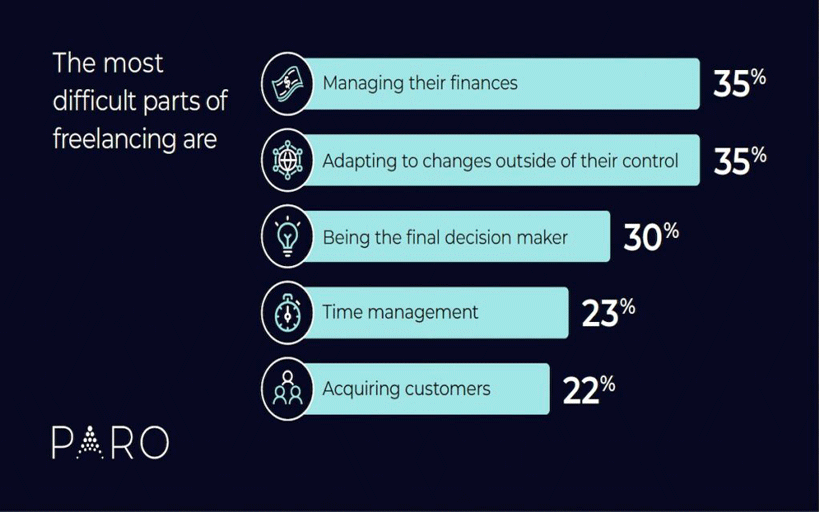As a freelancer, landing steady clients and earning a consistent income stream is a process. As your lifestyle goals change, you may find that you need to generate a higher income to compensate for billable hours or you need a team to increase your capacity. Do you have a strong foundation to scale your freelance business?
Overcome the common obstacles of running an independent operation and learn how to grow your freelance business into a sustainable organization.
Challenges in running a freelance business
Without the support of a full-time employer, you’re managing all aspects of a business on your own. Like many freelancers, you may find roadblocks in managing your finances or in creating enough demand for your skills.
According to a 2021 survey of over 2,000 knowledge workers, including current freelance professionals, these challenges are among several that can impede growth.

To grow your freelance business, you need practical strategies to organize your time, finances and value propositions so that you have the agility to expand.
The data you need to scale your business
To guide your plan for growth, assess your goals and those of your customers before taking action.
- Understand your customers: If you have a certain specialty, such as tax strategy for small businesses, it’s helpful to further examine your niche. Ask yourself whether there are customer types you consistently work with and how you can further address their needs. Then, you can understand your customers, speak about what you can do for them and set a pay rate that will reflect your unique value.
- Set KPIs: It’s one thing to work more hours and see your earnings grow in order to feel that business is going well. It’s another to examine where you’re driving the most success and where you should consider changes. By setting key performance indicators (KPIs), you can identify patterns in your performance and measure progress over time.
Set yourself up to go from freelancer to business owner
You’ve identified your ideal customer and set measurable goals to track your success. Now it’s time to address your main challenges and implement changes to make your operation adaptable.
1. Invest in better processes
Unorganized finances or poor time management will stop growth in its tracks. Consider standardizing or automating repetitive tasks, such as billing or low-lift project duties. This can lead to more productivity, ideally enabling you to enjoy why you chose freelancing in the first place.
And if you already have some solid processes in place, consider taking them to the next level. This includes:
- Investing in new software
- Hiring part-time administrative staff
- Refining your pitch or statement of work process
These processes will assist with your workflow, allowing you to scale your freelance business without burning out.
2. Work with a team
For many freelancers, working solo is attractive. But as you grow your business, a team can be a great asset for you and your customers. A team can add value by doing the following:
- Increase bandwidth for projects that require the same skill sets that you possess
- Offer cross-sell or upsell opportunities by employing someone with complementary skills
- Take administrative duties off your plate, so you can spend more time on high-level projects and strategy
Network with other professionals in your niche to develop working relationships.
3. Invest in yourself and your team
Business and technology are always changing. Whether you expand your own skills or employ someone with trending skill sets, you need to be able to adapt to evolving demands. Find ways to upskill yourself and your talent:
- Take courses outside of your comfort zone.
- Visit trade shows and other networking events to learn more about industry updates.
- Obtain additional certifications.
- Accept projects that stretch your experience.
- Work on your soft skills.
- Find a mentor.
4. Reconsider your rate
Many freelancers have a preference for one pricing strategy versus another. This can include hourly rates, a monthly retainer, weekly rates or set hours. Consider exploring other options to maximize your income.
Charging a retainer can give you some additional free time to spend on other duties, including training a team, learning new software or meeting new clients. Other pricing considerations include:
- Charging more to align with evolving market rates
- Focusing on higher paying clients
- Finding opportunities that don’t charge you fees
5. Reduce billable hours
Cutting billable hours can help free up your time to focus on other business needs. High-paying projects, working with another freelance professional or cutting back on short-term projects are some ways to do this. Think about the quality of your projects versus the quantity. Sometimes the “less is more” route can benefit you in ways that you didn’t initially think about.
6. Add passive revenue streams
Many freelancers focus on actively making money through their billables, but passive income offers faster scalability. Whether you offer subscriptions, courses, podcasts or other thought leadership for your customers to consume, there are many ways to monetize your insights without needing to double your projects.
Join a community of experts
Making the decision to scale your business can be exciting and challenging. To grow sustainably, you need to be organized and have the right support in place to stay flexible and competitive.
Paro’s platform allows remote finance and accounting professionals to take their business to the next level. Driven by AI, our experts are matched with qualified clients and receive helpful insights to manage their business, from professional development to administrative and billing support.








